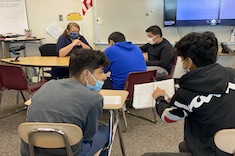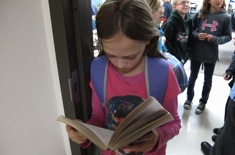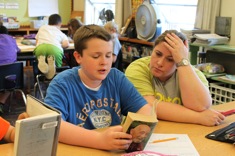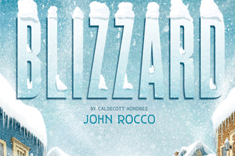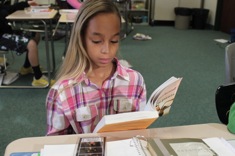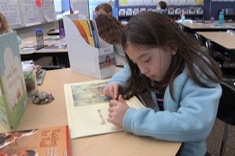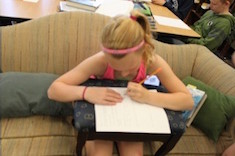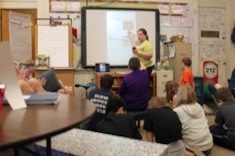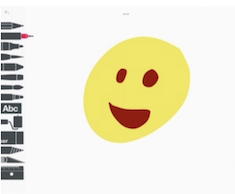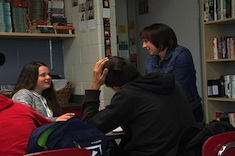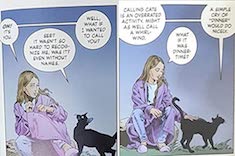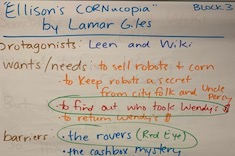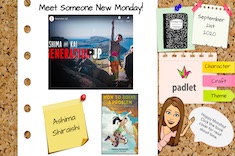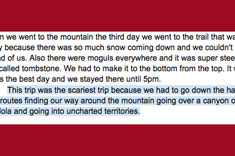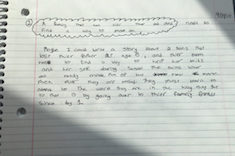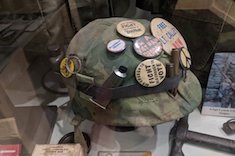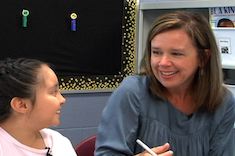6th
Latest Content
Minilesson: Using a Web Search to Help Visualize
Staci Revere helps her middle school multilanguage students learn to visualize by discovering images through a web search to understand the text in a deeper way.
The Classroom Library: Building Bridges
Cathy Mere presses to help children take the first steps in growing a sustainable reading life that carries beyond the classroom walls. She offers ways to build bridges to the school and public libraries as an essential step.
Finding Time for Read Aloud
Katherine Sokolowski makes a case for the importance of reading aloud to secondary students and offers suggestions to make it a reality. She includes a list of five surefire read aloud books for middle school students.
Ten Ways to Celebrate Writers
Jen Court gives 10 ways for students to share and celebrate their work as writers. Two downloads are included for you to use in your classroom.
Picture Books to Teach Conflict
Katherine Sokolowski shares a book list that inspires her to teach five different kinds of conflict.
Quick Take: Share Your Reading Struggles
Instructional coach Staci Revere reminds us of the importance of modeling our own reading lives for students, especially the parts where we struggle as readers.
Bring In the School Year Like a Grandma
Julie Johnson reflects on how to help students know they belong and are valued in a classroom community.
One Instructional Strategy Changes a Reading Community: Status of the Class
Mandy Robek reminds us of the power of a status of the class to build a reading community.
Combining Personal Narratives and Comics
Katherine Sokolowski combines personal narratives and comics to encourage students to go deeper in their storytelling.
Teaching Students How to Email
Katherine Sokolowski outlines the nitty-gritty on how to teach students to organize, manage, and compose email.
Sensible Reasons to Use Student Reading Records
Leigh Anne Eck outlines sensible reasons for students to keep reading records. She considers guidance for book selection, data for teachers, and entry points for reading conferences.
Making Connections with Sociograms
Gretchen Schroeder taps into the connections between characters by creating sociograms with her high school students.
From Seed to Blossom
Leigh Anne Eck provides a guide to developing an End-of-Year Reflection for students to consider their own growth, as well as offer advice regarding curriculum and instruction.
Importance of Talk in Writing Workshop
Julie Johnson reminds us of important mindsets to adopt to allow students the space and permission to talk while composing. When students talk as writers, they have opportunities to create new understandings, build relationships, and validate each other.
What Do Readers Need?
Christy Rush-Levine offers a close look into the needs of readers by considering engagement, enrichment, and nourishment. She offers three examples of reading conferences with students.
Best Graphic Novel Adaptations for the Middle Grades
Shari Frost shares her favorite graphic novel adaptations for the middle grades.
Teaching Summary
Christy Rush-Levine faces the challenge of helping her students see summary writing not as drudgery, but as a way to build more sophisticated thinking around texts.
Online Routines to Create Energetic Reading Communities
Melissa Quimby shares online routines to strengthen the class reading community.
Troubleshooting Difficulties When Writing a Big Idea in Memoir
Kate Mills and Tara Barnett pinpoint common difficulties in sixth-grade memoir. They share teaching points and student writing samples before and after revision.
Assessing Students Online: Small and Powerful Moves
Tammy Mulligan shares small and mighty moves when assessing students online.
Honoring Student Identity
Christy Rush-Levine considers how to communicate to all students that their presence and their identities are valued and appreciated.
Read Alouds in Content Classes
Mark Levine explains the many ways read alouds can enhance and deepen learning for middle school students in content areas like social studies and science.
Choice in Literacy Workshops
What makes choice authentic in literacy workshops? Christy Rush-Levine grapples with this tough question that leads to changes in her instruction.
Three Things Digital Tools Have Taught Me About Feedback
Christy Rush-Levine discovers that a move to digital feedback reveals many important truths about her middle school students, including insights into the effect of grades on how learners view response to their work.
Management and Middle School Workshops
Christy Rush-Levine lowers the tension level in her class over management issues by moving from irritation to curiosity, using her “inner chimpanzee” voice.
Sparking Ideas for Realistic Fiction
Tara Barnett and Kate Mills explain how they use examples from YA authors of how to mine everyday life for powerful ideas. They then help students move from ideas to blurbs as they start their realistic fiction drafts.
Building Interest Through Artifacts
Mark Levine has many students who haven’t traveled much more than 100 miles from home. He makes history come to life for them by bringing artifacts into his middle school classroom.
Historical Fiction Background Folders
Tara Smith finds that students in book clubs reading historical fiction are often confused because they lack background knowledge. Her solution is to create background folders that include key documents to support the history in the texts.
Balancing Conferences and Small Groups
Balancing small groups and conferences is essential for transferring learning from lessons and units, and it’s one of the trickiest tasks for teachers. Dana Murphy explains how she works toward balance in her classroom, weighing everything from the timeline of the unit to the intensity of the minilesson.
Navigating the Interpretation Process
Tammy Mulligan shares how she introduces students to the process of interpreting literature at different grade and developmental levels.
Browse Content By
Type
Category
- Assessment Tools
- Big Fresh Archives
- Booklists
- Choice Numeracy
- Classroom Design
- Common Core
- Community Building
- Conferring
- Content Literacy
- Digital Literacy
- English Language Learners
- Equity
- Family Relations
- Free Samples
- Guiding Groups
- Leadership
- Literacy Coaches
- Mentor Texts
- Minilessons
- New Teacher Mentors
- Podcasts
- Poetry
- Quote Collections
- Reading Strategies
- Self Care
- Struggling and Striving Learners
- Talking and Listening
- Teacher Study Groups
- Teaching Reading
- Teaching Writing
- Word Study and Vocabulary
Author
- Melissa Quimby
- Nawal Qarooni
- Gwen Blumberg
- Julie Cox
- The Lead Learners
- Hannah Tills
- Josie Stewart
- Ruth Metcalfe
- Mallory Messenger
- Becca Burk
- Jodie Bailey
- Vivian Chen
- Mary Brower
- Tiffany Abbott Fuller
- Stephanie Affinito
- Ruth Ayres
- Leigh Anne Eck
- Heather Fisher
- Shari Frost
- Julie Johnson
- Suzy Kaback
- Gigi McAllister
- Shirl McPhillips
- Melanie Meehan
- Cathy Mere
- Debbie Miller
- Tara Barnett and Kate Mills
- Tammy Mulligan
- Dana Murphy
- Bitsy Parks
- David Pittman
- Brenda Power
- Heather Rader
- Matt Renwick
- Mandy Robek
- Christy Rush-Levine
- Gretchen Schroeder
- Jen Schwanke
- Brian Sepe
- Katherine Sokolowski
- Stella Villalba
- Jennifer Vincent
Grade Level
Choice Literacy Membership
Articles
Get full access to all Choice Literacy article content
Videos
Get full access to all Choice Literacy video content
Courses
Access Choice Literacy course curriculum and training

